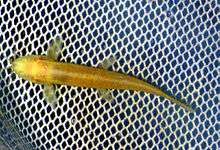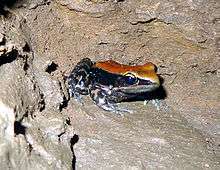Kotumsar Cave

Kotumsar cave was initially named Gopansar cave (Gopan = hidden) but the present name Kotumsar became more popular as the cave is located near a village named ‘Kotumsar’. Earlier, Kotumsar cave was in the Indian state of Madhya Pradesh. In 2000 it was in a new state, Chhattisgarh, carved out from the former as a new political entity. Kotumsar cave is a major attraction for people interested in ecotourism. It is a limestone cave formed on the Kanger limestone belt, situated near the bank of the River Kanger, a tributary of the Kolab River. The entrance coordinates are 18052’09”N; 81056’05” E (WGS 84) and it lies at an altitude of 560 m above sea level. A vertical fissure in the wall of a hill serves as the main entry for the cave, and from there for the convenience of tourists a concrete path has been made extending to the end of the cave. The main tunnel of the cave is nearly 200 m long with several lateral and downward passages. Various types of speleothems offer panoramic views . Air and water temperatures are relatively stable with an annual average of 28.25 ± 1.23 and 26.33 ± 0.96 °C, respectively (range = 25.0–32.7_C for air; 22.9–29.3 °C for water). The cave is subject to frequent flooding during the monsoon season, which generally begins in the middle of June and continues until the middle of October. The site is closed to tourists during this period. Various water pools fed by seepage throughout the year also exist in this cave .


According to Hindu mythology, caves are generally considered to be prominent religious locations. Many pilgrims visit Kotumsar cave to worship at a big speleothem formation (stalagmite) in one of the chambers. Earlier worshipers also burnt incense and camphor in this part of Kotumsar Cave, which polluted the cave ecosystem resulting in a decline of cave biodiversity. This practice was accordingly stopped by the authorities based on a report published by the National Cave research and Protection Organization, India.
History
The cave has been known since the British era of India, but it was not taken seriously until the 1950s when the geography professor Dr. Shankar Tiwari visited the cave and attempted to explore its chambers with limited resources and equipment. The cave was first systematically mapped in the 1980s by Dr. Jayant Biswas (then a PhD scholar), guided by a Romanian caver. The map was first published in Biswas's PhD dissertation in 1990, and in 1992 by him in the internationally recognized publication of the National Speleological Society .
New chamber
In 2011 a small but highly panoramic chamber was discovered and explored by forest officials. As the approach is not easy, it is closed to tourists. Mr. Shabuddin Shaik a young Biospeleologist from Andhra Pradesh of Acharya Nagarjuna University was trying to capture Kanger valley butterflies at the entrance gate of Kotumsar Cave.
Access
Kotumsar cave is situated in Kanger Valley National Park, which is around 35 km from the city of Jagdalpur, the district headquarters of Bastar, in the state of Chhattisgarh. Jagdalpur can be reached either by road, train or air. The city is well connected by National Highways 212, 202 and 16. The nearest airport is the Swami Vivekananda Airport of Raipur.
To reach the park one follows the Jagdalpur, Sukma road. The cave is located around 10 km from the main entrance of the national park.

Biodiversity
The Kotumsar Cave in Central India is one of the most biologically explored caves in India,.[1] While surveying the Kotumsar cave one of Dr. Shankar Tiwari's then colleagues Dr. S.M. Agarwal, a biologist took interest in the biodiversity of the Kotumsar cave. He identified a species of blind fish that occupy this cave as Indoreonectes evezardi (then Nemacheilus evezardi) with the help of the British Museum. New species of crickets namely Kempiola shankari were also discovered here. The name of the discovered critter was given in honour of Dr. Shankar Tiwari. Later on several other species were also discovered in the cave by taxonomists (mostly arthropods), geomicrobiologists from the National Cave Research and Protection Organization (India) also identified various bacteria that live in the cave.
The complete biodiversity of this cave has been well described by Dr. Jayant Biswas in the year 2010. There are many more caves are identified around 5 km radius of this caves, but Kotumsar cave is the most biologically live cave of Kanger Valley National Park having healthy biodiversity.


References
- ↑ Kotumsar Cave is biologically best known cave in India The Hitavada
- Biswas Jayant 2010 Kotumsar Cave biodiversity: a review of cavernicoles and their troglobiotic traits
- Biswas J 1991 Metabolic efficiency and regulation of body weight: a comparison between life in hypogean and epigean ecosystems
- Biswas J & Ramteke A 2008 Timed feeding synchronizes circadian rhythm in vertical swimming activity in cave loach, Nemacheilus evezardi
- Pradhan R K & Biswas J 1994 Towards regressive evolution: the periodic colour change behaviour of a troglophilic fish Nemacheilus evezardi (Day)
- Biswas et al 2011 Impacts of Ecotourism on Bat Habitats in Caves of Kanger Valley National Park, India
- Biswas et al 2015 Subterranean Microhabitat Dependent Intra Versus Extracellular Enzyme Secretion Capabilities of Deinococcus radiodurans
External links
- Cave biology (biospeleology) in India
- caves.res.in National Cave Research and Protection Organization, India